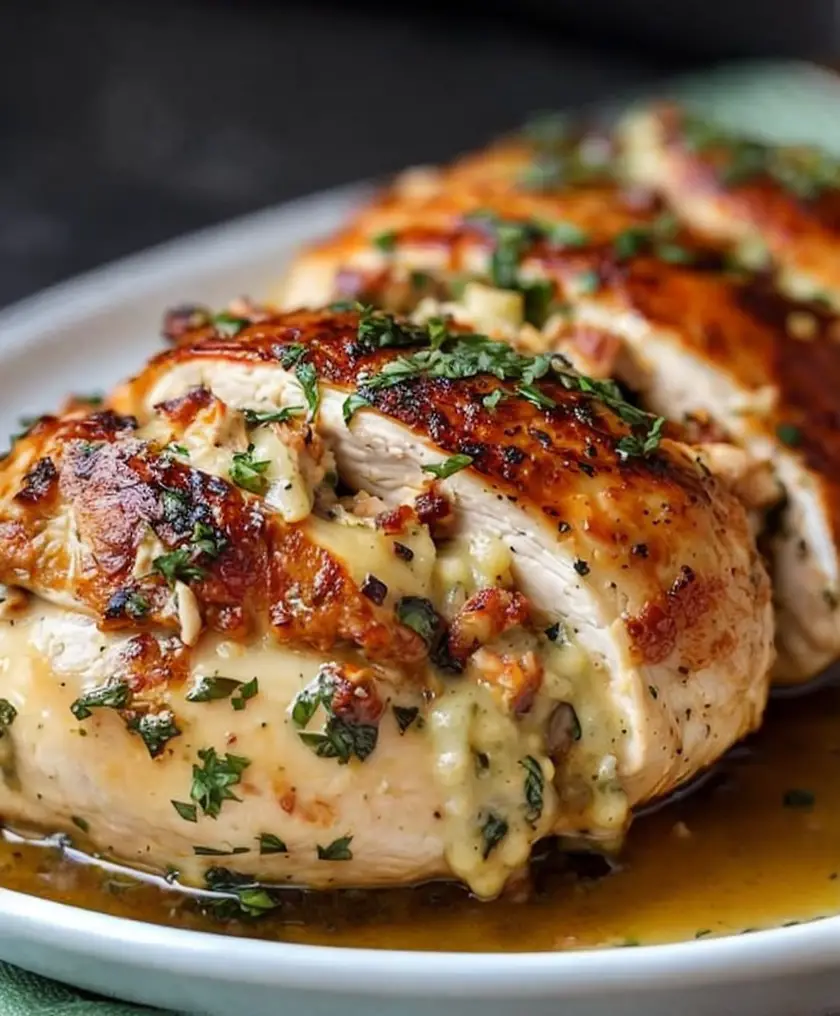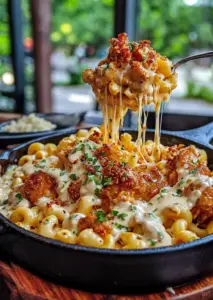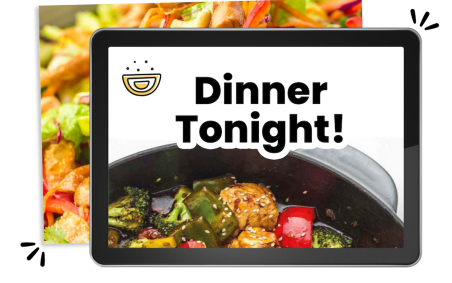Delicious Stuffed Chicken Breast: A Flavorful Delight
Stuffed chicken breast is a delightful dish that turns a standard chicken meal into an extraordinary culinary experience. This recipe features succulent chicken breasts filled with a savory mixture of ingredients that blend beautifully to create a flavor explosion in each bite. Imagine tender chicken, delicately seasoned and expertly opened to reveal a savory filling that oozes flavor. It’s a dish that not only tastes amazing but also looks impressive, making it perfect for a romantic dinner or a family gathering.
The versatility of stuffed chicken allows you to customize the filling to suit your tastes or dietary preferences. Whether you choose to stuff it with creamy cheeses, wholesome vegetables, or a mix of herbs and spices, each variation brings its own unique character and flair. The aromatic notes wafting from the oven will invite your guests to the table, eager to enjoy the feast. This recipe not only satisfies your hunger but also warms the heart, bonding everyone at the table over a shared love of delicious food.
Quick Recipe Highlights
- Flavor Profile: This dish features a well-balanced taste, combining savory chicken with rich, creamy filling and a hint of fresh herbs.
- Texture: Enjoy the contrast of tender chicken and a creamy, slightly crunchy filling that melds beautifully.
- Aroma: The scent of roasted chicken mixed with fresh herbs and melted cheese creates an enticing aroma that fills the kitchen.
- Visual Appeal: The golden-brown chicken presents beautifully, with a peek of green and white from the stuffing, garnished with fresh herbs.
- Skill Level Needed: This medium-level recipe requires basic cooking skills, making it accessible to home cooks of all abilities.
- Special Equipment: A sharp knife, kitchen twine, and an oven-safe dish are essential for perfecting this stuffed chicken breast recipe.
Recipe Overview
- Difficulty Level: While it may seem complex, this stuffed chicken breast recipe is manageable with clear steps. The key is to ensure you don’t overstuff the chicken, which can lead to a messy outcome.
- Category: This delicious dish can be served as a main course for lunch or dinner and is great for special occasions or weeknight meals.
- Cuisine: Combining elements from Italian and Mediterranean cooking traditions, this recipe embraces fresh ingredients and bold flavors.
- Cost: The recipe is cost-effective, utilizing affordable chicken breasts and pantry staples for the filling, making it budget-friendly for families.
- Season: Ideal for any season, but especially enjoyable during spring and summer when fresh herbs and seasonal veggies are at their peak.
- Occasion: This stuffed chicken breast is perfect for both casual family dinners and more formal gatherings, ensuring everyone at your table is satisfied.
Why You’ll Love This Recipe
The taste and texture of stuffed chicken breast are truly unmatched. It combines the tenderness of perfectly cooked chicken with a flavorful filling that melts in your mouth. Each bite delivers not just satisfaction but also a delightful surprise, making it a standout main dish. You’ll often find guests reminiscing about the meal long after it’s been served.
Convenience plays a significant role in the appeal of this dish. Stuffed chicken breast can be prepared in advance and stored, saving valuable time on busy weekdays. Preparing the filling can be done ahead of time, allowing you to assemble the dish right before cooking.
Packed with nutritional goodness, this recipe often includes vegetables, cheeses, or grains, making it a well-rounded meal. The chicken provides a lean source of protein, essential for maintaining a healthy diet, while the various fillings can introduce a wealth of vitamins and minerals.
Social interactions around this delicious meal only enhance its appeal. Stuffed chicken breast becomes the centerpiece of the table, inspiring conversation and connection with family and friends. It’s a dish that invites people to linger, share stories, and enjoy each other’s company.
Cost-effectiveness is another reason this recipe shines. With simple ingredients that can often be found at home or local markets, it’s an affordable option that doesn’t compromise on flavor. This recipe is not only delicious but also friendly on your wallet, making it a smart choice for everyday dining.
Historical Background and Cultural Significance
The origin of stuffed chicken can be traced back to traditional cooking practices in many cultures around the world. Various cultures have celebrated the art of stuffing meats with a variety of ingredients to enhance flavor and create hearty meals. From the Italian “pollo farcito” to Mediterranean dishes, the idea of stuffing poultry has stood the test of time.
In many culinary traditions, stuffing not only serves to enhance flavor but also allows for creative expression in the kitchen. Different regions have their unique touch on the stuffing, making it a symbol of culinary diversity. For example, in Italian cuisine, you might find a filling made of ricotta and spinach, while in the Middle East, spiced rice and nuts might take center stage.
Over the years, as culinary techniques have progressed, stuffed chicken breast recipes have evolved. Modern approaches celebrate both traditional flavors and contemporary dietary preferences, offering a wide array of filling options ranging from gluten-free to vegan alternatives. This adaptability has kept the dish relevant and enjoyable across generations.
Regional variations also contribute to the rich tapestry of stuffed chicken recipes. Countries from Europe to Asia adapt this dish to fit their regional tastes, using local herbs, spices, and seasonal vegetables, thus embracing global culinary influences and flavors.
Ingredient Deep Dive
Upon choosing chicken breast as the base for this dish, it’s essential to understand both its cultural significance and nutritional benefits. Chicken is historically a staple protein in many cultures representing nourishment, warmth, and comfort. Nutritionally, chicken breast is low in fat and high in protein, making it an excellent choice for health-conscious individuals.
When selecting chicken breasts, look for those that have a pinkish color and are firm to the touch, avoiding any that appear discolored or have an unpleasant smell. Properly storing chicken is key to maintaining freshness; it should be kept refrigerated and used within 1-2 days of purchase.
Cheese is another integral component of stuffed chicken breasts. Cheeses such as mozzarella, feta, or cream cheese add richness and creaminess to the filling. Each cheese offers its unique flavor profile and contributes to the overall mouthfeel of the dish. Cheese is also packed with calcium, essential for bone health, adding nutritional value.
For storage, cheese should be kept covered in the refrigerator and used within its use-by date for the freshest quality. When substituting cheese, consider nut-based options for a dairy-free alternative.
Fresh herbs and vegetables are common additions to stuffed chicken, enhancing flavor and introducing various vitamins and minerals. Basil, spinach, or sun-dried tomatoes offer unique spins on the filling. Selecting herbs should involve looking for vibrant, fragrant bunches—avoid any wilting or browning leaves. Fresh herbs should be stored in the refrigerator, either wrapped in a damp paper towel or in a glass of water, while vegetables should be used promptly for peak freshness.
Common Mistakes to Avoid
- Overstuffing the chicken can lead to burst seams while cooking. Aim for a moderate amount of filling.
- Not securing the chicken properly with twine or toothpicks may lead to an uneven cook and loss of filling.
- Using undercooked chicken results in safety hazards; always utilize a meat thermometer.
- Neglecting to season the chicken can result in blandness; a good amount of salt and pepper is essential.
- Skipping marinating or pre-seasoning can cause the stuffing to overpower the chicken flavor.
- Choosing low-quality or expired ingredients can lead to an unsatisfactory outcome.
- Oven temperature mishaps can affect cooking time; always preheat your oven thoroughly.
- Not allowing the chicken to rest after cooking can cause juices to escape, leading to dry meat.
- Taking shortcuts on preparation time may lead to overcooked stuffing while waiting for the chicken to finish.
- Forget to garnish or serve with a fresh side can miss the chance to elevate the dish visually and nutritionally.
Essential Techniques
When preparing stuffed chicken breast, properly seasoning the chicken is crucial. Seasoning adds depth to the flavor, ensuring every bite is enjoyable. Use a mix of salt, pepper, and herbs, and allow the chicken to marinate for at least 30 minutes for maximum flavor infusion.
Cutting the chicken breast to create the perfect pocket is essential for successful stuffing. Use a sharp knife to make a horizontal incision, being cautious not to cut all the way through. This method creates a spacious pocket for stuffing while keeping the breast intact.
Securing the chicken with twine or toothpicks prevents the filling from escaping during cooking. Tie the chicken breast snugly, ensuring it holds its shape while cooking, and remove the twine before serving for a clean presentation.
Monitoring an appropriate cooking temperature is vital to achieve a safe and moist outcome. Using a meat thermometer to check that the internal temperature of the chicken reaches 165°F ensures it is cooked through without drying out.
Pro Tips for Perfect Stuffed Chicken Breast
Begin by selecting the best-quality chicken. Fresh, organic chicken breasts yield better flavor and texture than processed options. Pairing them with high-quality gourmet cheeses or freshly herbs can elevate your dish significantly.
Consider preparing your stuffing a day in advance. Allowing the stuffing to rest enables flavors to meld, bringing out the essence of each ingredient when cooked. The advantage of prepping ahead also prepares you for a quick assembly on the day of cooking.
Experiment with different cheeses for varied flavor profiles. Cream cheese offers a tangy creaminess, while feta adds a salty kick. Mixing cheese varieties can create delicious depth in your filling.
Utilize an oven-safe skillet for cooking. By searing the chicken on the stovetop and then transferring it to the oven, you can create a beautifully golden crust while preserving the juiciness of the chicken.
Don’t forget about presentation! A sprinkle of fresh herbs or a drizzle of balsamic reduction can transform your dish into a gourmet experience, pleasing both the eye and the palate.
Resting the chicken after cooking allows the juices to redistribute evenly throughout the meat, ensuring that every slice is juicy and tender. A 5-10 minute rest makes a world of difference.
Consider serving your stuffed chicken with a complementary side dish. Seasonal vegetables or a fresh salad will balance the meal, enhancing the overall dining experience and aiding digestion.
Pay attention to cooking times based on size variations of chicken breasts. Larger breasts may take longer to cook properly, while smaller pieces might cook quicker—it’s important to adjust as necessary.
Variations and Adaptations
You can easily adapt stuffed chicken breast to fit regional tastes. For instance, a Mexican twist might incorporate jalapeños, cheddar cheese, and black beans into the filling, topped with avocado or salsa before serving.
Seasonal adaptations can elevate the dish according to what’s fresh and available. Spring might inspire a brighter filling of asparagus and lemon-infused cream cheese, while autumn could lead you to a stuffing with pumpkin and sage.
For those with dietary restrictions, substitute traditional ingredients with alternatives like gluten-free breadcrumbs or dairy-free cheeses. This provides inclusivity while maintaining delicious flavors.
Flavor variations could also enhance your stuffed chicken. Adding sun-dried tomatoes, olives, or roasted garlic would create Mediterranean vibes that everyone will enjoy.
Experiment with different textures in your stuffing. Incorporating nuts or grains like quinoa can add both crunch and heartiness, creating a more substantial meal and added nutritional benefits.
Lastly, consider presentation alternatives. Stuffed chicken breast can be sliced to reveal the filling or served whole. Serving may involve individual portions or sharing platters, all depending on the occasion and setting.
Serving and Presentation Guide
Effective plating techniques can make a huge impact when serving stuffed chicken breast. Begin by creating a clean base using sauces or purees for an elegant backdrop. Adding colorful vegetables around the plate offers a visual contrast that enhances appeal.
Garnishing ideas can range from freshly chopped herbs to drizzles of olive oil or sauces. A sprinkle of parmesan over the top just before serving creates an inviting look and additional flavor.
Traditional accompaniments to stuffed chicken might include homemade bread or a crisp green salad, which add both texture and flavor balance. More modern servings could involve a side of roasted vegetables or quinoa for a healthy touch.
Temperature considerations play an important role in serving. Stuffed chicken is best served warm, so consider letting it rest for a few minutes before presenting. This ensures all components shine at their best.
When it comes to portion control, consider the needs of your guests. For larger gatherings, serving smaller pieces can encourage sampling and increase overall enjoyment of the meal.
Wine and Beverage Pairing
When selecting wine pairings for stuffed chicken breast, consider a light-bodied white wine such as Chardonnay or Pinot Grigio, which complements the chicken without overpowering the dish. These wines enhance the creaminess of cheese-based fillings and the brightness of herbs present in the dish.
For red wine lovers, a medium-bodied Merlot or Pinot Noir can also pair nicely, providing a gentle contrast to the flavors without overwhelming the palate. Look for a wine that balances fruitiness with subtle acidity to match the dish.
For non-alcoholic alternatives, consider sparkling water infused with citrus, which invigorates the meal while cleansing the palate. Freshly brewed iced herbal tea can also provide a refreshing accompaniment.
If coffee or tea works better for your meal, follow with a light, herbal tea post-dinner to aid digestion. For those who prefer coffee, a mild roast can enhance the meal without a strong aftertaste.
Temperature is essential; ensure white wines are served chilled and reds at room temperature for optimal flavor. For coffee, a medium warmth will allow the full flavor profile to emerge without overwhelming the taste buds.
Storage and Shelf Life
When it comes to storing stuffed chicken breast, it’s essential to cool leftovers to room temperature before refrigerating. Place in an airtight container and store in the fridge for up to three days for optimal freshness.
If you need to freeze, wrap the stuffed chicken tightly in plastic and then in aluminum foil to prevent freezer burn. Properly stored, it can last for up to three months in the freezer, allowing for quick meal options on especially busy days.
Signs of spoilage include off smells or changes in color and texture. It’s essential to do a quick check before reheating to avoid unappetizing experiences.
To reheat, place stuffed chicken in the oven at 350°F until warmed through. Consider adding a splash of broth to maintain moisture, ensuring the chicken remains tender.
If needed, reduce the reheating time by cutting stuffed chicken into smaller pieces, allowing for quicker and even heating throughout.
Freezing cooked stuffing separately is also a practical idea to maintain the unique flavors when you’re ready to use it, ensuring any leftovers are just as delicious.
Make Ahead Strategies
Preparing stuffed chicken breast doesn’t have to be a last-minute affair. Creating the filling a day in advance allows flavors to meld, enhancing the taste when you cook. Store the filling in an airtight container in the refrigerator until you’re ready to use.
You can also prepare the chicken by creating the pocket and securing it with twine or toothpicks hours before cooking. Just keep the wrapped chicken in your refrigerator until it’s time to bake.
Quality should always be a priority; however, cooking chicken and then storing it in the fridge can affect flavor. Reheating properly is key to enjoying the dish fully.
Assembly tips include seasoning the chicken right before cooking to maintain flavor intensity. Additionally, consider freezing extra ingredients like herbs and cheese to have on hand for future meals.
Evaluate the quality impact by testing different stuffing types to see how they hold up after rain. Ingredients like cream cheese maintain their texture well even after freezing.
To elevate fresh elements, add a drizzle of fresh sauce or garnish right before serving to make the dish feel newly prepared, giving it a vibrant and appealing finish.
Scaling Instructions
Scaling stuffed chicken breast recipes requires careful adjustments. To halve the recipe, simply cut your ingredient measurements in half and adjust your cooking time based on size variations in chicken breasts.
When doubling or tripling, consider a larger baking dish and allow for additional time to ensure all pieces cook thoroughly while keeping an eye on internal temperature.
Equipment adjustments may be needed; for instance, larger batches may require multiple pans or preheating the oven longer to maintain ideal temperature for even cooking.
Keep timing modifications in mind while cooking; be prepared to check doneness regularly. Utilizing a meat thermometer can help ensure each piece achieves that perfect, juicy outcome.
Storage considerations should also be addressed; if cooking in larger amounts, be sure to allow enough cooling space to safely store leftovers without crowding.
Distributing the cooking process helps ensure a successful outcome. Allow your first batch to cook completely before beginning the next, maintaining consistent quality throughout your meal preparation.
Nutritional Deep Dive
Analyzing the macro breakdown of stuffed chicken breast shows a well-rounded meal. Chicken typically offers high protein content of approximately 26g per serving, essential for muscle repair and growth.
The inclusion of cheese and vegetables further contributes to micronutrient analysis. Spinach, for example, adds iron, vitamins A, C, and K, while cheese provides calcium for bone health.
Consider health benefits like the lean protein of chicken in combination with nutrient-rich veggies, which can support weight management and overall wellness when consumed in moderation.
Dietary considerations include assessing the sodium and fat content, primarily from added cheeses and sauces. Using low-fat cheese options or fresh herbs can enhance flavors while reducing unhealthy components.
Understanding portion analysis is crucial; an appropriate portion size can mitigate overeating. Aim for a balanced plate that includes vegetables or whole grains alongside the stuffed chicken.
Weight management tips suggest being mindful of ingredients used for stuffing, making subs when needed to lower calorie counts without losing flavor.
Dietary Adaptations
Creating a gluten-free version of stuffed chicken breast is simple. Substitute breadcrumbs with gluten-free alternatives like crushed nuts or gluten-free oatmeal to achieve the same texture without compromising flavor.
For a dairy-free option, use plant-based cheeses or tofu spread. This adaptation maintains creaminess while accommodating vegan diets, ensuring everyone can enjoy the dish.
Vegan stuffed chicken concepts can inspire creativity in the kitchen. Consider using lentils or mushrooms as primary stuffing ingredients, along with herbs and spices for flavorful profiles.
Low-carb enthusiasts can swap out starch-based fillers for vegetables like zucchini or cauliflower rice, thoroughly mixing them into a robust filling.
The keto diet can also thrive with a stuffed chicken approach. Utilizing cheese-heavy fillings and leafy vegetables allows for compatibility with low-carb lifestyles, providing satisfaction without excess carbs.
Embracing a Paleo diet can lead to stuffing with ingredients like nuts and dehydrated fruits, offering a sweet contrast to the savory chicken.
Finally, exploring low-FODMAP options may involve withholding onions or garlic from fillings; herbs like thyme or parsley can replace the complex flavors without causing discomfort.
Troubleshooting Guide
For texture issues, informing how to properly cook chicken ensures moistness. Avoid overcooking by checking internal temperatures to allow tender bites.
Flavor balance concerns can arise if the filling is too salty or bland. Adjustments during preparation may involve incorporating fresh herbs or spices for added punch right before stuffing.
Temperature problems may emerge from an unpreheated oven or inconsistent cooking times. An oven thermometer can help maintain proper settings for juicy chicken.
Equipment challenges like a malfunctioning oven can alter outcomes. Consider adapting with a stovetop method or slow cooker to ensure food safety while achieving desired results.
Ingredient substitutions can cause surprises in flavor and texture. Test any unfamiliar replacements beforehand to understand how they fit within the recipe framework.
Timing concerns arise when guests are on their way; always prepare ahead to mitigate stress. Utilize the freezer effectively or pre-prep ingredients for speedier assembly.
Recipe Success Stories
Community feedback regarding stuffed chicken showcases versatility in creativity. Tales of families gathering around the table to share this dish often surface, creating cherished memories filled with flavors and laughter.
Several variations, from sun-dried tomato fillings to Mediterranean-inspired versions, have gained popularity, giving readers fresh ideas for creating their exciting spins on the classic recipe.
Adaptation stories include substitutions catering to dietary preferences, inspiring inventive approaches towards healthier cooking that still satisfy cravings for indulgent-tasting meals.
Readers frequently suggest experimenting with different ingredients or local specialties to elevate their stuffed chicken experiences, encouraging collaboration and culinary exploration.
Inspiring readers to take captivating photographs of their culinary creations fosters a sense of community, welcoming all food enthusiasts to engage and connect surrounding delicious recipes.
Frequently Asked Questions
Can I use bone-in chicken breasts?
Absolutely! Using bone-in chicken can enhance flavor and moisture, but you may need to adjust cooking times to ensure the meat is thoroughly cooked.
Is it possible to grill stuffed chicken breasts?
Yes, grilling adds a smoky flavor. Just ensure to secure the stuffing well, and keep an eye on the heat to avoid burning the exterior before the inside is cooked.
How do I know when the chicken is done?
The internal temperature should reach 165°F. Using a meat thermometer is the most reliable method to check for doneness without cutting into the chicken.
Can I prepare the stuffing in advance?
Yes! The stuffing can be made ahead of time and refrigerated, letting flavors meld overnight, which can enhance the dish’s overall taste.
What can I do with leftovers?
Leftover stuffed chicken can be stored in an airtight container in the refrigerator for up to three days. It can be reheated in the oven or enjoyed cold in salads or sandwiches.
Can I make this recipe dairy-free?
Yes! Substitute with dairy-free cheese options or creamy hummus to achieve a similar texture and flavor without using dairy products.
What salads pair well with stuffed chicken?
A fresh garden salad, Mediterranean chickpea salad, or roasted vegetable salad complements the stuffed chicken beautifully, enhancing the meal experience.
Can I freeze the stuffed chicken?
Yes, you can freeze the stuffed chicken before cooking. Just make sure to wrap it tightly to prevent freezer burn. Thaw in the refrigerator before cooking.
Is there a substitute for chicken breast?
Yes, other poultry like turkey breasts or even thin cuts of pork can work well. Adjust cooking times according to the type and thickness of the meat.
Can I use pre-cooked ingredients in my stuffing?
Absolutely! Using pre-cooked ingredients can save time. Just ensure your stuffing is heated correctly to avoid any food safety issues.
Additional Resources
Looking for more delicious inspiration? Check out our collection of related recipes like herb-roasted vegetables or creamy garlic mashed potatoes, perfect complements to your stuffed chicken. Don’t forget to explore our technique guides that focus on chicken preparation and skillets tips to elevate your cooking skills.
Need ingredient information? Our seasonal produce guides provide insights on what veggies are in-season, enhancing your meals with freshness throughout the year. Equipment recommendations can also help, with suggestions for must-have kitchen tools to make your cooking experiences easier and more enjoyable.
Seasonal variations may inspire new ideas; think about incorporating summer zucchini or fall squash into your stuffing for a delightful twist on this classic dish.
Join the Conversation
We encourage you to share your experiences with this stuffed chicken recipe! Post photos on social media using our unique hashtag, connecting with fellow food enthusiasts who appreciate the art of good cooking.
Photography tips can further enhance the showcasing of your dishes, ensuring they look as delicious as they taste. Your feedback and reviews will not only inspire others but allow for continued community engagement.
Explore recipe variations! Share your ideas on innovative ingredients or methods for stuffed chicken, creating a collaborative space for everyone eager to elevate their culinary skills together.
The Recipe
Stuffed Chicken Breast
Serves: 4
Prep Time: 15 mins
Cook Time: 30 mins
Total Time: 45 mins
Kitchen Equipment Needed
- Sharp knife
- Kitchen twine or toothpicks
- Oven-safe dish
- Meat thermometer
Ingredients
- 4 boneless, skinless chicken breasts
- 1 cup cream cheese
- 1/2 cup spinach, chopped
- 1/4 cup sun-dried tomatoes, chopped
- 1/2 cup shredded mozzarella cheese
- 2 cloves garlic, minced
- Salt and pepper, to taste
- Olive oil, for drizzling
Directions
- Preheat the oven to 375°F (190°C).
- Using a sharp knife, create a pocket in each chicken breast without cutting all the way through.
- In a bowl, mix cream cheese, spinach, sun-dried tomatoes, mozzarella, garlic, salt, and pepper until well combined.
- Stuff the chicken breasts with the cheese mixture and secure with twine or toothpicks.
- Drizzle olive oil over the stuffed chicken and season with additional salt and pepper.
- Place in an oven-safe dish and bake for 30 minutes or until the chicken is cooked through.
- Allow to rest for 5 minutes, then slice and serve.
Recipe Notes
- Feel free to customize the filling ingredients based on your preferences or dietary needs.
- Ensure to monitor the chicken’s internal temperature to achieve the best results.
- This dish can also be frozen before cooking for later use.










